Menus
- A very high-end and very techno vision of fast tourism
- 3 cylinders in line, 798 cm3, 110 hp at 10,150 rpm, 80 Nm at 7100 rpm, 192 kilos, € 21,490
- Discovery
- In the saddle
- Engine and transmission
- In the city
- On motorways and main roads
- On departmental
- Part-cycle
- Brakes
- Comfort and duo
- Consumption & autonomy
- Conclusion
- Video test of the MV Agusta Turismo Veloce 800 Lusso SCS
A very high-end and very techno vision of fast tourism
3 cylinders in line, 798 cm3, 110 hp at 10,150 rpm, 80 Nm at 7100 rpm, 192 kilos, € 21,490
Be careful not to say anything, you will upset them: from the mouth of Giovanni Castiglioni, son of the eminent – and late – Claudio and current director of MV Agusta, this, an anecdote truly collected between dessert and coffee , is not a traditional touring motorcycle. Not at all, even. However, with its slender line, its high posture on legs and its pair of side cases, it could have interfered without worry among the plethora of big trails that we meet on all the roads of Europe, the beautiful season came. . GS, Multistrada, Turismo Veloce: one more, what !
Never mind: the object that concerns us today is, according to him, "a sporty, but comfortable". Giovanni continues: “Not everyone wants a big, fairly placid sausage, there are people for whom the beauty of the object matters as much as the intensity of the sensations, because life is too short to ride sad ”. To this we could add that a certain target of bikers is really sensitive to technological content and this is the case of the SCS version of this new MV Agusta Turismo Veloce 800 Lusso (hell name, right?).
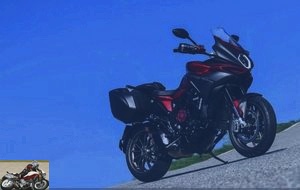
SCS stands for "Smart Clutch System", in other words an intelligent clutch that will allow you to do without the clutch lever in 99% of cases. MV Agusta claims that beyond the drudgery of being on the clutch all the time in town and in traffic jams, this system brings a new driving experience. This is what we will see.
In the meantime, the SCS has requested two years of development. It comes from an American supplier: Rekluse. It already offers similar kits, adaptable to cross-country or enduro motorcycles and which make it easier for riders to get out of tough times. Obviously, adapting it to a heavy and powerful motorcycle, with an engine entirely controlled by electronics is another thing and all the software has been done in-house at MV Agusta. And to judge the merits, we were able to do two loops of around 100 kilometers mainly on mountainous roads north of Varese, from the MV Agusta factory, with precisely the 800 Lusso equipped with a gearbox. 6 classic (in white and gray in the photos) and a SCS (in red in the photos). Action !
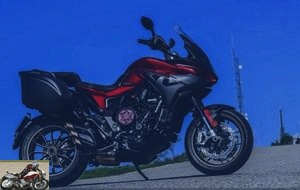
Discovery
Here we are: what one might think of as a "vulgar" element of tuning (arrgh, I know some who will fail reading this sentence), like those dry clutches that can be seen on some Ducati, is not one! On the contrary, it is a significant technological innovation. Suddenly, the MV Agusta Turismo Veloce 800 Lusso has a classic clutch, under a black casing; the SCS version (which costs € 1,800 more) can be recognized by the presence of this translucent cover which reveals the red clutch plates, as well as the standard side cases. They only have a capacity of 30 liters each, but MV Agusta says it’s a compromise that keeps light and compact, while still allowing for a short weekend for two. In addition, we will notice the particularly tapered look of the rear part, once these cases are removed..
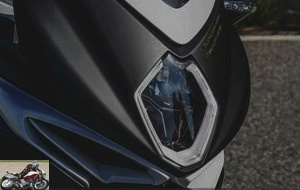
We note the good build quality and the use of beautiful parts: the least of things, obviously, since we put all this in perspective in our conclusion, in the price aspect.
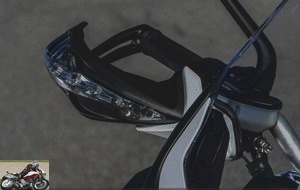
It should also be noted that the two Lussos (standard and SCS) complete the range of Turismo Veloce 800, made up of a “basic” version (€ 16,990) and an RC in the colors of the brand’s racing motorcycles ( € 22,390): they justify their surname Lusso by a very complete equipment which you will have the list in the paragraph below.
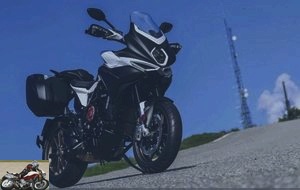
In the saddle
It is quite high, this saddle: at 850 mm, it will not be for garden gnomes and members of David Pujadas’ fan club who like to put both feet on the ground. Plus, it’s either go or nothing: no adjustments or optional low saddle. Do not expect to gain a few millimeters by using dessert to pack the suspensions (good excuse, however!): Although electronically controlled, they remain firm. The saddle compensates, however, with its not too steep edges and a certain finesse at the junction with the tank..

Good. Imagine that you have the required template to take a seat on board. You will then enjoy the two levers and their micrometric adjustment. Then you will have to familiarize yourself with the dashboard and all the electronics present. Fortunately, the interface is fairly easy to understand: the main menus are aligned at the base of the color TFT screen and you then navigate through the sub-menus using a main button on the left stalk. In fact, you can adjust the piloted suspensions (solo or duo, with or without luggage), the level of the heated grips, the level of traction control (8 possibilities, plus off), activate the data acquisition (a downloadable App on an iPhone then allows you to know, thanks to a GPS chip, your route, the speed, the level of throttle opening, the angle taken at each location). That’s not all: there is also a cruise control with limiter function, an on-board computer, as well as three maps which can be adjusted with the starter button.
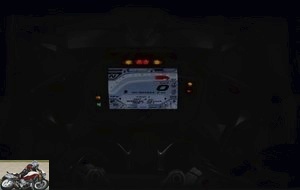
By default, the bike is in “touring” mapping with traction control on 2. The Turismo Veloce Lusso has the good taste to keep in memory the last setting selected by the driver (rider? After all, it’s an MV Agusta! ) switches off the ignition, but you should know that when the “rain” map is selected, the traction control level automatically switches to 8, the highest. And if you change the engine casing, you must then go and adjust the traction control level downwards: for safety reasons which are easily understood, the machine does not automatically remove the level of the guardrails; this must be the result of a reasoned action by the pilot.
Engine and transmission
The three-cylinder in-line engine marked the legend of MV Agusta in GP at the turn of the 70s. But it also allowed the brand to relaunch, notably by offering new ranges of 675 then 800 cm3, the second displacement being derived from the first.
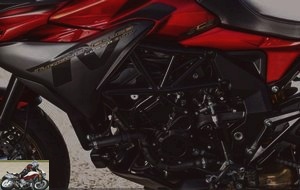
The 800 block has evolved a bit over time and in this 2018 vintage, with changes made to the balancing arm, timing chain tension and primary transmission. However, the power and torque values have not changed despite the change from Euro 3 to Euro 4: so we still have 110 horsepower at 10,150 rpm and a decent torque of 80 Nm at 7,100 rpm. As we can see, the difference between the torque and maximum power revs suggests good elasticity, a characteristic specific to the three cylinders. This engine also stands out for being the only one in this segment to have a counter-rotating crankshaft, which in theory improves the agility of the bike. We’ll talk about that later. Last point: a fairly ordinary sound at idle, where the mechanical noises cover those of the exhaust; on the other hand, in the towers, it meows well and it backfires when you use the shifter near the red zone. A delight…. for lovers of sporting sensations.
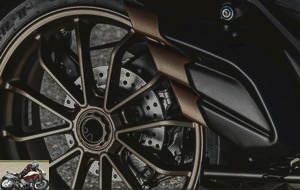
So, let’s stop beating around the bush, or for that matter, the translucent sump and talk about SCS. The principle of the SCS comes from an American box, Rekluse, as we have said, which offers kits to be installed after-market on cross-country and enduro motorcycles: benefit for the user, more ease in technical portions, since all you have to do is weld the gas and that’s it !
The principle of this clutch with automatic function is relatively simple: in a classic clutch, there are discs and plates (8 and 10 on a Turismo Veloce with the conventional gearbox). In the SCS, there are a little more: 10 and 12. On one of the newcomers, there are weights (six, exactly), which will be able to allow it to exert a centrifugal force. The rest is electronic software, which will decide, based on speed, rpm and throttle opening, when to open. Or not. It will also be noted with great joy that the two new Lussos have an up and down shifter as standard, which is not otherwise flawless..
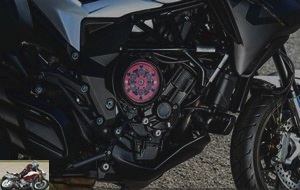
Concretely, it’s simple: if you always have to start using the clutch if you are in gear (a safety measure, says MV Agusta, which consists in always making the user aware that it has clutch), we can forget the left lever in 99% of cases. And what is the remaining 1%, you ask yourself with an undisguised eagerness and thirst for knowledge: quite simply if you want to do wheelies, an activity which contributes at least as much to the general improvement of the lot of humanity as regular viewing of Touche not at my post, but after all, why not.
So let’s come back to our SCS: in reality, the system is stunning. Triple bluffing. First, because it sends the clutch lever back to the rank of antiquity. We don’t use it anymore. A roundabout, a red light, a slowdown, a traffic jam? The lever, who cares: the bike stays in first, or even second, without stalling. To set off again, a little trickle of gas, then an action on the shifter and in the car, Simone !
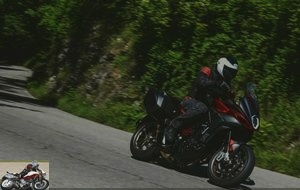
The SCS is all the more impressive because it accepts everything: a little maneuver for parking, you can stay in first, without the clutch and reverse the bike. Magic. More vicious: we tested the start in second, third, sixth (this is not really recommended for the duration for the clutch and you will then race up to 60 km / h with a low Chinese scooter. range – pleonasm – before the torque of the three cylinders allows you to revive a little better). We tested the gas start in full force, it really drops off and MV claims that, on a 0 to 100 km / h, the SCS is faster than the standard version, unless you are a drag pilot in life (which is not that said).
The second source of surprise is the transparency of the system: first, let go of the clutch abruptly as if you wanted to stall like a big idiot or a first-time beginner with a license. Nothing. Nothing happens. Not a vibration, a shake, a quiver, a ripple, whatever, a blink of an eye. Nothing, nothing, nada. SCS keeps the bike from stalling, it’s that simple. And the system works seamlessly.
Third source of inspiration: the fact that after 5 minutes, we understood (a fat lazy slumber in every human being, right?) That we would no longer use the left hand. And driving this SCS becomes absolutely natural.
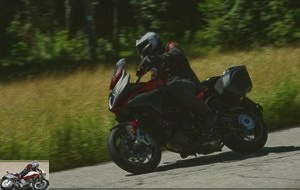
Yeah, I see some there, sitting in the back, near the radiator, minds devious. And they think that if the only brake to your happiness on a motorcycle is the clutch lever, there is also the Honda DCT solution. Except that MV Agusta has principles: for them, techno enhancement, it weighs 36 grams. Not ten kilos. It makes sense in one of the paragraphs below: can you guess which one ?
But first, one last info: SCS or not, it does not affect the revisions of the bike. First oil change at 1000 km, then every 15,000 ….
In the city
Although a little rough at low revs, as has been said, the three-cylinder is flexible enough to handle cruising around boulevards in fourth at around 2,500 rpm. The response to the throttle is sometimes a little hesitant at very low revs, this sometimes happens with certain ride-by-wire, including those from brands with higher sales volumes. We get used to it.
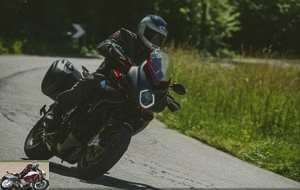
Just as we put up with the virtual disappearance of the clutch lever. It’s very simple, you quickly forget that it exists. We’re not going to say that it changes your life, but at the same time you get used to it very well and also very quickly. Opposite, the 6-box Lusso is also doing quite well, in particular thanks to a fairly flexible clutch control which does not manage to forget that the selector is quite rough to the feeling..
Without being prohibitive, the turning radius is in the good average. On the other hand, we note the absence of warnings, the fact that the engine heats up quickly in town and releases calories on the left side. In addition, the indicators are quite exposed (integrated in the hand guards at the front and on the license plate holder at the rear). They may not stand the density of Parisian traffic for long, but Paris is not the world, fortunately.

On motorways and main roads
Based on the double principle that, small one, it is not on the large axes that the clutch is used the most and that, small two, an up & down shifter is standard on both versions of the Lusso, it’s a bit kif kif.
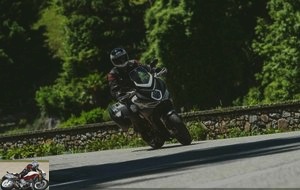
Before setting off, we will therefore, with a firm and determined movement, raise the screen to the high position, thanks to the small plastic appendage located at its base. The protection then climbs up a notch, which deflects the air a little at the shoulders, but not completely on the top of the helmet, which is likely if you are a little tall, given the height of the saddle.
Otherwise, at 130 km / h, the three-cylinder rotates at 6000 rpm in sixth. And we’re not far from entering the maximum torque zone, so the covers are kind of copious. And the top speed is given at 230 km / h, which is always useful if you want to tour Germany. We didn’t go at those devilish speeds, but from what we saw the stability is good.
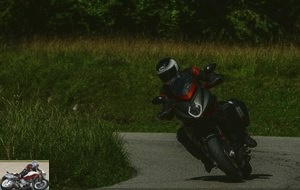
On departmental
Warning: here’s a good asshole bike! And this is a compliment: it means that it offers such temptations that not even the Dalai Lama will be able to go 80 km / h with, because he does not have enough willpower, Dalai! He’s like that, Dalai, his flesh is weak too and the MV Agusta Turismo Veloce 800 Lusso SCS is a temptress of the devil.
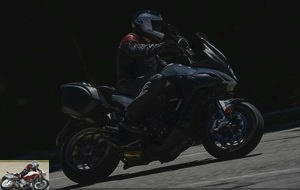
We would also like to thank the MV Agusta forerunners for not entering the inter-manufacturer competition for those who drag themselves the most. Here, we still know how to turn the throttle in the right direction, which gives us the opportunity to really test the motorcycles.
And we have to admit that when Giovanni Castiglioni says that his bike is a "comfortable sports car", well, he’s right. It may be annoying to be handsome, to have tattoos all over the place and to drive an ABT-ready Audi RS6, he is damn right.
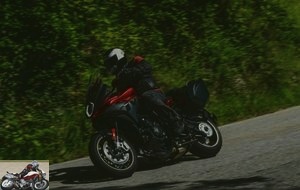
The MV does not like departmental. No. She loves them: because her front end is incredibly precise. The 192 kilos are not felt at all. On its handlebars, you are surprised quite quickly to adopt a surprisingly sustained pace for a "touring" motorcycle. Tightening a trajectory, abruptly raising the bike out of a corner to exit a turn like a cannonball, taking advantage of excellent traction, the MV knows how to do it. It provides real driving pleasure, relies on a quality cycle part and it can be argued that in its niche, no competitor offers such agility or such precision. Here, you often have the impression of riding a sporty 600, but comfortable and with a large handlebars..
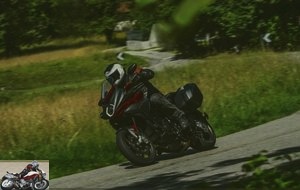
MV Agusta remains on its fundamentals and that’s good.
Part-cycle
Here, it’s high level: the tubular aluminum trellis is connected to two suspension elements from Sachs: the fork (160 mm travel, 43 mm diameter) and the rear shock absorber (165 mm travel) are controlled by a piloted system that adjusts the parameters depending on whether you are driving alone or with two people, loaded or not.
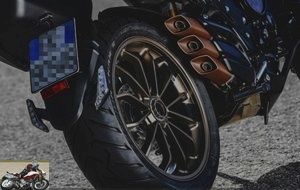
We will praise the quality of the suspensions, which, although typified a little firm (but without excess), offer a good compromise between damping and rigor, especially in terms of traction. There is still a bit of attitude when braking, but this does not affect the ability to turn around like a starving person. As such, we note the excellent performance of the Pirelli Scorpion Trail II, which brilliantly combines grip and precision..
Brakes
Brembo everywhere: Radial 4-piston calipers bite into 320mm rotors up front, while the rear trusts a 2-piston caliper that squeezes a 220mm disc. The rear is not very powerful and the ABS is sensitive to it. You take comfort in the front, which doesn’t offer that much bite at first glance, but the power is there when you pull the lever. Best of all: corner braking, no problem! And that reinforces the evil side of the Turismo Veloce chassis.
The SCS is a game-changer with a parking brake, in the form of a small lever above the brake pedal. Useful….
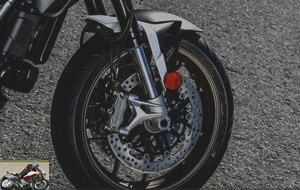
Comfort and duo
We never bought an MV Agusta because we were cozy (David?) And it won’t start with this Turismo Veloce 800 Lusso. Nonetheless, she is indeed a "comfortable sports car". The saddle is a little firm, without turning to the board of fakir either and the suspensions do their job well. The protection is correct and the Geraldine will be able to count on a fairly generous space at the rear, with well-sized grab handles. It is without a doubt the friendliest MV Agusta.
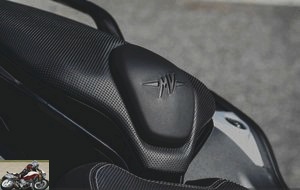
Consumption & autonomy
We were unable to test consumption on this test. The tank is however 21.5 liters, which should in theory give a decent autonomy. The motorcycle is homologated with an average consumption of 5.8 l / 100 (equivalent to emissions of 129 grams of CO2).
Conclusion
Attention, here is the section that stings: € 21,490 for a "trail 800" which makes 110 horsepower, this is a new peak, we agree. So, of course, it’s also an MV Agusta: small series, high-end components, a legendary brand, Giacomo Agostini, all that. But also, and that’s no small thing, an astonishingly efficient and precise chassis and a really angry three-cylinder in the towers. Without forgetting, for geeks, the contribution of the SCS, totally bluffing in use.
Still: a Yamaha Tracer 900 costs exactly half as much. This gives the price of the Italian exception to its true value, when we see that a Ferrari 488 GTB Pista is worth three times the price of a Nissan GT-R, which deposits almost as much. This is also the Italian miracle.
But a MV is not necessarily a rational choice. It’s an Epicurean’s bike, from someone who wants to stand out, who seeks more precise sensations than in the all-rounder of motorcycle production. Yes, it is expensive, yes it is not necessarily essential, but it has the merit of existing; and once you get on the handlebars, you tell yourself that going without the clutch lever is "elementary, my dear Watson." In the meantime, we are grateful to MV Agusta for offering precisely these sensations, this finesse, this feeling, which cannot be found on other mass-produced machines. The badge is not overused.
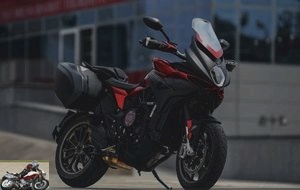
Strong points
- Operation and approval of the SCS
- Engine character in revs
- Handling
- Front axle precision
- Feeling of lightness
- Quality of suspensions
- State-of-the-art electronics
- Full color TFT instrument panel
- Driving pleasure
Weak points
- Feeling at the selector a little dry on the SCS
- Shifter a little rough on the Lusso (not SCS)
- Some hesitation of ride-by-wire at low revs
- Frankly premium price
- Saddle a little firm
- Any sound at low speed
- A little lack of torque at low revs
- Sensitive ABS at the rear
The technical sheet of the MV Agusta Turismo Veloce 800 Lusso SCS
Test conditions
- Itinerary: two loops of around one hundred kilometers from the MV Agusta factory in Varese (Italy)
- Motorcycle mileage: 1300 km
- Problem encountered: the clutch lever is so 2017 !
The competition: Ducati Multistrada 950 (power side) and Multistrada 1260 (price side, except that we have 158 hp!), KTM 1090 Adventure, possibly Triumph Tiger 800 XRt, Yamaha Tracer 900
Video test of the MV Agusta Turismo Veloce 800 Lusso SCS
Related articles
-
Test MV Agusta Turismo Veloce 800
The TGV (High Speed Tourism) according to MV Agusta A motorcycle completely redesigned for tourism and equipped with real saddlebags. MV Agusta…
-
MV Agusta Superveloce 800 motorcycle test
Neo-retro in the right tempo 3 cylinders of 798 cm3, 148 hp, 88 Nm, 173 kg, 20,300 euros Concept bike adapted in an ultra exclusive limited series, the…
-
4-stroke single cylinder, 445 cm3, 34 hp at 7000 rpm, 36 N.m at 5500 rpm, 148 kilos dry, € 5,490 A nice and versatile neo retro roadster Is it the return…
-
MV Agusta Rush 1000 motorcycle test
0 to 100 km / h in 2.9 seconds! All in excess ! 4 cylinders in line, 998 cm3, 212 hp and 116.5 Nm, 186 kg dry, 300 copies, 34,000 euros The success of…
-
Screaming metal ! Between 1966 and 1972, the mecanica Verghera (MV) won six world titles with three cylinders 350 and 500. It is to celebrate them that…
-
The Italian exception lavishes strong sensations. Really strong ! 3 cylinders in line, 798 cm3, 140 hp at 12,300 rpm, 87 Nm at 10,100 rpm, 175 hp, €…
-
MV Agusta Brutale 1090 RR test
Shock ticket With 80 cm3 and 5 more horsepower than the 990 R, the “big brutal” is positioned at the top of the pyramid in the great family of roadsters….
-
Baby GS: the Trail is back Paradox. It is by imposing its flat on the Paris Dakar, that BMW has shifted the market from mono to twin, causing the…
-
V2, 821 cm3, 109 hp at 9,250 rpm, 86 Nm at 7,750 rpm, 180 kilos dry, from 11,450 € Ducati’s mid-size roadster is getting a makeover and fine-tuning the…
-
Harley-Davidson Forty-Eight and A2 test
1202 cm3, approx. 60 horsepower at 5500 rpm, 96 Nm at 3500 rpm, 252 kilos with full tank, from 12,410 € A minimalist and very stylish machine, generous…
To answer some comments, for me no motorbike is useful, it is above all a passion above all and like any passion we can do without it but we are unhappy.
How can one manage to criticize such a machine?
OK the aesthetics can open some debates, but like everything we can not have all the same tastes (fortunately), for the rest the chassis, the brakes, the engine and all the rest are only beautiful parts. Ah if I were rich I would buy it just as decoration in my living room, it could be enthroned next to the Panigale, the MV, the RSV 4, the 660 RS, the z900RS and the RocketIII, but unfortunately I don’t have any, so I’m happy with the ones in my garage and god damn it I’m happy as soon as I get on one of them. Never after soon 30 motorcycles with 7 different brands have none of them disappointed me, I take a foot every time I ride … and yes that’s the passion to become addicted to it, it’s been 42 years since it lasts and it does not weaken this love for motorcycles. So I like this 1290 SDR, otherwise for the one that does not appeal to me I do not read the articles
18,200 euros and with the Powerparts 24,000 euros options, I have friends in Ardèche who had the RSV4 and who sold it because it was practically unusable in this region. I have always juggled two motorcycles, one for fun and one for utility (work, sleep), often Yam or Honda. but at 18,000 euros to get only 50%, it stings
And suddenly, what did they buy back from your friends in Ardèche?
One bought himself a custom Suzuki SV, the other messed up and bought a Buell (true), I rode with them and we had a blast.
In addition it leaves money to avoid eating at Mac Do but in small nice restaurants. For the occasion I was in Triumph.
Wow from an RSV 4 to a customized SV !!!!! There may have been intermediate solutions not?
I especially think that your friends certainly did not have the level or the means to have this kind of bikes.
I also saw happy owners of this type of machine send serious and with a very clean driving (trajectories, braking …) and when arriving at the top of the passes (Alpes and Hautes Alpes) they were serene and happy, which did not prevent them from eating in good little restaurants
The mono 390 was not supposed to disappear in favor of the bi 490 in the transition to Euro 5 ???
I don’t quite understand the placement of these 300 / 400cc motorcycles, if I had the A2 license, I would prefer a larger displacement engine, not restricted, like the formidable twin of the Honda CB 500 or the 650 Royal Enfield, at least we recover a little torque at low and medium speed.
You will tell me that to do solo TT a 390 is enough, but not 172kg!
I find it strange to release this 390 when the twin-cylinder 490 is announced. The tariff will remain.
Otherwise I like the concept and the look.
Too funny the guy who wants "a very reliable BMW" instead….
Superb motorcycle. For info the 490 will not replace the 390 but will come as a complement, just like the 890 will not replace the 790.
172 kg with the full it is not heavy (same weight as the 300 versys and 310 GS) KTM never makes an anvil, more the cycle part is often hyper balanced. When I see how an 1190 and 790 Adventure and 390 Duke handles I am confident of the capabilities of this bike on small twisty roads. For me, its only big flaw is its saddle height, higher than the 790 … too bad because I would have given it to my wife.